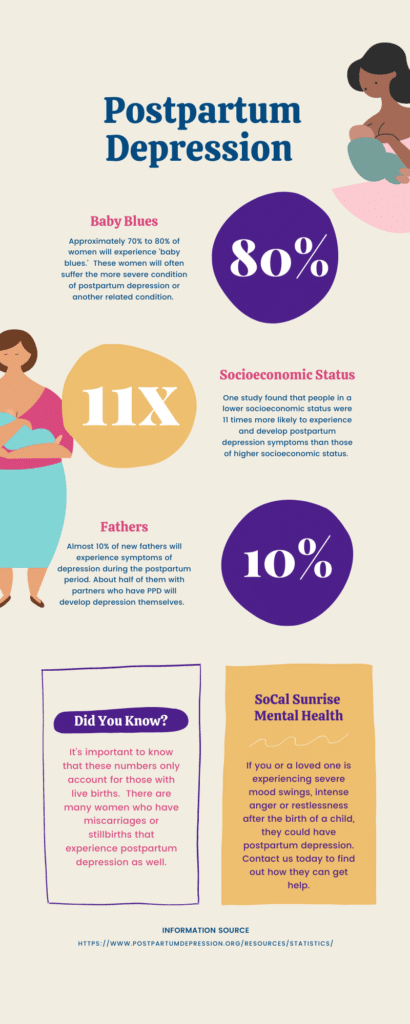Postpartum depression is recognized as a subtype of major depression and affects women who have given birth. Around 20 percent of mothers will experience PPD after childbirth. If you or a loved one is going through a pregnancy knowing the signs and symptoms of postpartum depression could help.

Postpartum Depression
Postpartum depression is recognized as a subtype of major depression and affects women who have given birth. Around 20 percent of mothers will experience PPD after childbirth. If you or a loved one is going through a pregnancy knowing the signs and symptoms of postpartum depression could help.
Table of Contents
Postpartum depression (PPD) is a form of major depression characterized by physical, emotional, and behavioral symptoms that occur after a woman gives birth. Women who are diagnosed with PPD begin experiencing symptoms within four weeks of delivering a child. 1
PPD often happens due to chemical, social and psychological changes that occur after having a baby. Chemical changes in new mothers involve a rapid drop in the hormones estrogen and progesterone, which increased significantly during pregnancy. New mothers experience several other physical and emotional changes that contribute to PPD.1
A majority of women who deliver a baby experience “baby blues” after doing so. Around one in ten of them end up developing longer-lasting and more severe depression, or PPD. Around one in a thousand can develop postpartum psychosis, which is an even more severe condition.1
Fathers may also experience depression shortly after their child is born. About one in ten new fathers experience this kind of depression. Fortunately, counseling methods and medications can help new mothers and fathers who experience feelings of depression after childbirth. 1
Types of Postpartum Depression
Baby Blues
Post Partum Depression
Postpartum Depression (PPD) usually occurs a few days or months after childbirth and occurs after giving birth to any child. PPD can include symptoms similar to that of baby blues but are much more severe and last far longer.1 Symptoms usually onset within the first few weeks of giving birth but can also start during pregnancy and up to a year after childbirth.2
PPD can cause women to disengage in regular activities and stop functioning as they normally would. It is essential to seek treatment for PPD, or the symptoms may worsen over time. Medication and counseling can both help in the treatment of PPD.2
- Sings and symptoms of PPD may include:
- Depressed mood 2
- Sever mood swings 2
- Excessive crying 2
- Issues bonding with the newborn2
- Withdraw from friends and family 2
- Disinterest in the newborn 3
- Appetite issues 2
- Sleep challenges 2
- Overwhelming fatigue 2
- Lack of interest in once pleasurable activities, including sex 3
- Intense anger and irritability 2
- Fear of not being a good mother 2
- Hopelessness 2
- Misery 2
- Feelings of worthlessness, shame, or guilt 2
- Difficulty with concentrating, remembering details, or decision making 3
- Restlessness 2
- Severe anxiety or panic attacks 2
- Thoughts of self-harm or of causing harm to the newborn 2
- Fear of being left alone with the newborn 3
- Constant thoughts of death or suicide 2
Postpartum Psychosis
Postpartum psychosis is a rare and severe mental illness that can affect women very soon after delivering a child. It typically begins in the first two weeks of childbirth, and only about 4 in 1,000 new mothers experience it.4
It is imperative to seek treatment for postpartum psychosis right away. Medication is usually a part of the treatment plan for women who experience postpartum psychosis. Hospitalization may be necessary if the affected woman is experiencing difficulty refraining from hurting herself or others. 1
- Sings and symptoms of postpartum psychosis may include:
- Feeling confused or disoriented 2
- Obsessive thoughts about the newborn 2
- Hallucinations or delusions 2
- Sleep distrubances 2
- Excessive energy 2
- Restlessness or agitation 2
- Paranoia 2
- Reckless behaviors that aren't typical 4
- Rapid mood swings within several minutes 4
- Attempts to self-harm or to cause harm to the newborn 2
Postpartum in Fathers
Causes
A variety of factors most likely causes postpartum depression. Some of the causes may include:
Changes in Hormone Levels
Levels of the hormones estrogen and progesterone rapidly decrease hours after a woman gives birth. The decrease in hormone levels may trigger depression as more minor hormonal changes can trigger mood swings and tension in premenstrual syndrome. 6
History of Depression
Mothers who have experienced depression at any point in their lives or are currently experiencing depression are more likely to develop postpartum depression. 6
Emotional Disturbances
Many women encounter feelings of doubt related to pregnancy. If they are experiencing an unplanned or unwanted pregnancy, they may feel strange emotions towards their fetus. Women often take some time to adjust to the idea of having a baby, even when they have planned their pregnancy. Women may also experience sadness, anger, or guilt if she births a sick child who needs to stay in the hospital. 6
Fatigue
Childbirth can cause mothers to feel extremely tired, and it can take weeks for them to adjust and regain their energy. Cesarean birth can result in an even longer waiting period before strength and energy come back. 6
Lifestyle Changes
Some new mothers may experience a lack of support from others. A support system is often an important thing to have after giving birth. Some may also experience stressful life events like losing a loved one, an illness in the family, or a big move. 6
Risk Factors
There are additional factors that may place new mothers at a higher risk of developing postpartum depression.
- Factors include:
- Personal or family history of depression or anxiety 6
- Family history of a postpartum disorder 6
- Premenstrual dysphoric disorder (PMDD) 6
- Lack of support in caring for the newborn 6
- Financial challenges 6
- Marital issues 6
- Complications during pregnancy, childbirth, or breastfeeding 6
- Recent major life event 6
- Having multiple children to care for 6
- Having an infant in neonatal intensive care 6
- Past fertility treatments 6
- Thyroid imbalance 6
- Any form of diabetes 6
If any of these risk factors are present before, during, or after pregnancy, it is essential to discuss with a doctor who will help implement an effective prevention plan.
Postpartum Depression During COVID-19
Complications
It is crucial to find ways to prevent or treat postpartum depression. If it is left untreated, it can cause additional problems. Women with untreated postpartum depression often experience symptoms much longer than they would have if they sought treatment. In some cases, it may even become a chronic depressive disorder.2
Postpartum depression also has a ripple effect and can cause stress for everyone close to the baby, not just the mother. If a new mother experiences postpartum depression, the father becomes more likely to experience depression as well. Additionally, children of mothers with postpartum depression are more likely to experience emotional and behavioral issues, including difficulties sleeping and eating, excessive crying, and developmental delays. 2
Prevention and Treatment
Fortunately, there are preventative measures and treatment methods that may help expecting mothers. Women who have a history of depression should speak with their doctor about plans for pregnancy or once pregnancy begins. 2
During the pregnancy, a doctor can look for signs of depression and administer a depression screening questionnaire. This questionnaire can be done both during pregnancy and after delivery. They may suggest support groups, counseling, or another form of therapy for mild depression. They may also recommend antidepressants during pregnancy if the feelings of depression are severe enough. 2
After childbirth, a doctor might screen for signs and symptoms of postpartum depression closely following the birth. This way, they can begin treatment as early as possible. Women who have a history of postpartum depression might begin therapy or antidepressant treatment immediately following childbirth. 2
Treatment for postpartum depression can be beneficial for the mother and her newborn, as PPD can create severe health effects for both of them. Most women who seek treatment experience improvement in their symptoms. 2
Psychotherapy
Cognitive Behavioral Therapy (CBT)
CBT is used to help treat depression and anxiety by teaching new thought and behavioral patterns in response to situations. Individuals in CBT learn to alter harmful thoughts and behaviors to recover from depressed and anxious feelings. This type of therapy can occur individually or in a group setting with individuals who experience similar issues. 9
Interpersonal Therapy (IPT)
IPT is used to help treat different forms of depression, including postpartum depression, by helping to improve communication skills in relationships, create networks of support, and develop realistic expectations in dealing with crises. IPT is based on the idea that life experiences influence mood. 9
Medication
Many women who experience postpartum depression use antidepressants as a part of their treatment. These medications improve mood by altering chemicals in the brain. They can take up to 6 to 8 weeks to become effective and often improve sleep, appetite, and concentration issues before improving mood. It is vital to give the medication time before deciding that it doesn’t work. 9
It is essential to work with a doctor when starting antidepressants while breastfeeding to help reduce exposure to the newborn. The risk of the issues to the infant as a result of exposure through nursing is very low, but new mothers may find it beneficial to work with a doctor to find the proper form of treatment for their situation. They may need to try several different medications before finding the right one.9
Individuals taking antidepressants should not stop taking them without consulting a doctor or other healthcare professional. Abruptly stopping these medications can cause withdrawal symptoms and may cause depression to return quickly. A doctor can help reduce usage over time to avoid any unwanted symptoms. 9
The different forms of postpartum depression, including baby blues, postpartum depression, and postpartum psychosis, can be detrimental to the health of new mothers, new fathers, and their new baby. In the era of COVID-19, more individuals than usual may be affected by postpartum depression, and symptoms can be even more severe. It is crucial to speak with a doctor if you or a loved one suffer from postpartum depression. 9
References
- Postpartum Depression: Symptoms, Causes, Risks, Types, Tests, Professional and Self-Care. (n.d.). Retrieved from https://www.webmd.com/depression/guide/postpartum-depression
- Postpartum depression. (2018, September 01). Retrieved from https://www.mayoclinic.org/diseases-conditions/postpartum-depression/symptoms-causes/syc-20376617
- Postpartum depression. (n.d.). Retrieved from https://www.apa.org/pi/women/resources/reports/postpartum-depression
- Postpartum depression (2019, May 14). Retrieved from https://www.womenshealth.gov/mental-health/mental-health-conditions/postpartum-depression
- Depression Among Women. (2020, May 14). Retrieved from https://www.cdc.gov/reproductivehealth/depression/index.htm
- Postpartum Depression. (n.d.). Retrieved from https://www.acog.org/womens-health/faqs/postpartum-depression
- Santos, P., & Galvan, J. (2021, April 16). Coronavirus pandemic blamed for increase in postpartum depression, anxiety in new mothers. Retrieved from https://www.ksat.com/news/local/2021/04/16/coronavirus-pandemic-blamed-for-increase-in-postpartum-depression-anxiety-in-new-mothers/
- Postpartum Depression/Anxiety During COVID-19. (n.d.). Retrieved from https://mhanational.org/postpartum-depressionanxiety-during-covid-19
- Perinatal Depression. (n.d.). Retrieved from https://www.nimh.nih.gov/health/publications/perinatal-depression/index.shtml
